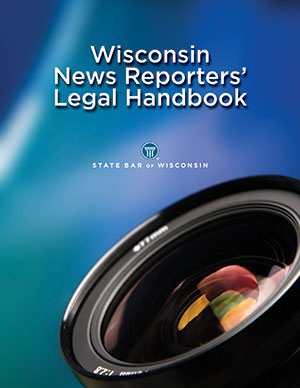
Attorney Andy Phillips, like many folks, looks back a bit wistfully at the “good old days.”
“I wish it was back in the day where I could go home at 6 o’clock and sit down with the paper for a half hour,” says Phillips, whose practice at von Briesen & Roper, Milwaukee, includes government and school clients – people often in the public spotlight. “But that’s just not the way society works anymore. I wish I could go home at 6 o’clock and not have my phone ring all through the night or get emails through the night. It doesn’t work that way either.”
How journalism and communications work today has undergone dramatic change in the past decade or so, with profound implications for anyone caught up in a news story, especially lawyers and their clients.
The rise of iterative journalism, the dominance of social media, and the sheer speed of modern communications have placed an even greater premium on understanding and practicing the fundamentals of effective crisis communications.
“It used to be you could control the story for a day and really form a message before it got out there,” Phillips says. “But now everything is so instantaneous and oftentimes you’re reacting. It’s difficult to be thoughtfully proactive.”
5 Rules for Damage Control
How can a person plan to be thoughtfully proactive? At Hennes Communications, we tell every client about what we call the “damage control playbook” and its five simple rules:
 Thom Fladung, managing partner of Hennes Communications in Cleveland, worked for 33 years at newspapers, including stints as managing editor of the Detroit Free Press, The Plain Dealer in Cleveland, and the Akron Beacon Journal as well as editor of the St. Paul Pioneer Press in Minnesota.
Thom Fladung, managing partner of Hennes Communications in Cleveland, worked for 33 years at newspapers, including stints as managing editor of the Detroit Free Press, The Plain Dealer in Cleveland, and the Akron Beacon Journal as well as editor of the St. Paul Pioneer Press in Minnesota.
1) Tell the truth. Even if you don’t believe doing so is the morally correct approach, it’s the pragmatically correct approach. If you don’t tell the truth, you’ll lose credibility, making all communications that follow suspect. And the truth will come out. If you haven’t told the truth, you’ll now be accused of a cover-up. Remember, often damage from the cover-up exceeds the damage from the actual misstep.
2) Tell it first. If you don’t, someone else will – and then you’ll have lost control of your message. We frequently advise clients who know bad news is going to break to break the news themselves. Then, the story won’t be an “exclusive” broken by a reporter or revealed by a whistleblower or posted by a Facebook user. It’s your story. Tell it yourself.
3) Tell it all – or tell as much of it as you can. There are legal and legitimate reasons for withholding some detail. Privacy issues must be considered. The Health Insurance Portability and Accountability Act (HIPAA) and the Family Educational Rights and Privacy Act (FERPA) may come into play. You might not know many of the details at the outset of a crisis. But you can count on the fact that details inevitably emerge. You know the context, history, and background behind your crisis. The more you can tell of your story, the more you’ll control it.
4) Tell it fast. The world moves at the speed of Twitter. To effectively practice crisis communications and protect your reputation, you must move with it.
5) Tell it to the people who matter most. A person or organization caught up in a reputation-threatening crisis should care most about the people who really care – employees, customers, business partners, board members, donors. They’re watching, wondering what’s going on – and waiting to hear from you.
Lawyers Helping Journalists Understand Legal Concepts Improves Our Justice System
 Have you ever had a reporter phone to ask what a legal term means? Law is complicated, and reporting the law can be challenging – especially for newer reporters.
Have you ever had a reporter phone to ask what a legal term means? Law is complicated, and reporting the law can be challenging – especially for newer reporters.
Because helping journalists understand the court and legal system makes our justice system even better, the State Bar of Wisconsin, in collaboration with the Wisconsin Broadcasters Association and the Wisconsin Newspaper Association, offers the recently updated Wisconsin News Reporters’ Legal Handbook free of charge.
The 60-page book has information that not only helps reporters understand the law but also helps lawyers understand how the media works and intersects with our justice system. For example, Chapter 2 covers electronic newsgathering in the Wisconsin Court System, and covers cameras in the court, sound and lighting criteria, still photography, judicial guidelines for media inquiries, and more.
The original Media-Law Relations Committee, formed in 1979, developed the handbook to increase understanding and cooperation among the news media, the judiciary, and Wisconsin lawyers. The committee included lawyers, judges, and media representatives.
Lawyers are encouraged to read the handbook and share it with reporters and law firm staff who may interact with reporters and other media representatives. Wisconsin News Reporters’ Legal Handbook is available for download at www.wisbar.org/newsreporter.
To learn more, contact Mike Wiltse, public relations specialist, mwiltse@wisbar.org.
Writing for Right Now
The evolution and widespread adoption of a practice called iterative journalism has been a game-changer – for the journalists who practice it and the people subject to it. Understanding iterative journalism is basic modern media literacy, and understanding what it means in a crisis communications situation is vital.
Put most simply, iterative journalism means this: Stories are published online as they’re reported, in pieces, or iterations. Once basic facts are known, the story goes online. Calls are still made to key sources. But if you don’t take that call or return it fast, the story is going to be posted online without you.
In its highest, best use, iterative journalism is dynamic, tailored to the immediacy and interactivity of the web. Readers’ questions and suggestions shape developing stories. Sources who in a previous age might have taken days or weeks to respond are flushed out. The very process of journalism is opened to everyone.
Big, breaking stories can be reported in real time as important facts become known – perfect for the modern reader on a smartphone. A story published iteratively by one publication can be picked up on by others, which then do additional reporting and explore new angles, building toward a better end for readers.1 A skilled iterative journalist can construct an investigative package, piece by piece, over days or weeks, right before the readers’ eyes. The process can yield great journalism.
The common first instinct is to hope the story will go away. It almost certainly won’t. A story will be told.
Arguably, this has blown much-needed fresh air into rooms full of people grown staid and out of touch with readers.2 (An old newsroom joke: What are the four most depressing words in a newspaper? “First in a series.”)
Iterative journalism also can lead to lazy journalism.3 A reporter can skip calling every key person – much less checking facts and claims against other credible sources. If the basic facts are known, no additional effort is necessary to include nuance.
And for news outlets, speed is paramount: Being first with the breaking news means being first (or close to it) on that Google search page. That can mean thousands more readers – and additional revenue to the news outlet.
In the pre-internet age, legions of journalists were schooled by tough editors who screamed, “You don’t have the story yet!” After more calls, more research, sitting outside sources’ offices, leaving business cards in doorjambs, sending certified mail … journalists prayed they had enough of the story so the editors would stop screaming.
That basic journalism tenet – we don’t print the story until we have the entire story – has been shattered.
What might it all mean to you? Remember the damage control playbook. If you or your organization is thrust into the news, be prepared to quickly respond and get your side in that crucial first story, which sets the tone for each of the follow-up iterations.
Media-savvy news subjects know how to respond in a crisis and how to talk to a reporter to buy time. We suggest to clients that, if their point of view is not in the original online story, they should resist having it added as an “update” to that story. Why? Many readers will never see the updated version. When was the last time you went back to check if a story was updated online – especially stories you’re reading on your smartphone? The more effective course: If you’re not in the first story, ask for a new story, with a new headline, with your point of view reflected.
For lawyers and their clients, of course, the stakes include the looming legal matters.
“I’m trying to counsel my client to be mindful that there is a legal strategy in play here that we don’t want to jeopardize but at the same time the public has a thirst for information,” Phillips says. “The speed to the outward world is going to be very, very rapid. So, we want to control what information is going to be made public and make sure that [information] is not going to jeopardize our legal position.”
The Rise of Social Media – And How to Use It
The Pew Research Center reported in December 2018 that for the first time, social media sites surpassed print newspapers as a news source for Americans, with about 20 percent of U.S. adults saying they often get news via social media; 16 percent said they often get news from print newspapers. In 1996, the Pew study showed 72 percent of people surveyed read a newspaper daily and only 12 percent were going online for news.4
According to Pew research in 2019, 7 out of 10 American adults use some type of social media. In 2005, only 1 in 20 adults in the United States used social media.5

“It used to be you could control the story for a day and really form a message before it got out there. But now everything is so instantaneous and oftentimes you’re reacting. It’s difficult to be thoughtfully proactive.” – Andy Phillips, von Briesen & Roper, Milwaukee
For people and organizations caught up in crises, social media may seem like a primary threat. It’s often where crises begin and where critics rally. It’s also a powerful weapon for getting your messages and your side of the story out – particularly to those important internal audiences such as your employees and your customers.
People who care most about you and your organization will go to your website when they hear you may be caught up in a controversy. They’ll go to your Facebook page. They’ll follow your Twitter feed.
They’re waiting to hear from you. And we’ve found that an organization’s most important audiences, if they hear from the organization first about its side of the story, are much more likely to believe it. In many cases, this holds true regardless of what people hear later via social media or conventional media.
“I represent the (Wisconsin) Counties Association,” Phillips says. “It represents the interests of all 72 counties in the state. And they are very, very in tune with social media – Facebook, Twitter, YouTube to an extent. And they’re very in tune with getting their message out with social media. I think it just depends on the savviness of a lot of my clients as to whether they’re proactive as to getting their message out on social media.”
With that opportunity, though, comes responsibility.
“The one thing that I’ve seen as problematic is if you have a social media platform you’ve got to monitor it,” Phillips says. “And you’ve got to make sure the message out there is consistent with what you want out there.”
Monitoring Social Media is Crucial
Monitoring social media for reputation threats is essential for several reasons:
-
Social media is an effective early warning system for problems. You’ll want to know as soon as possible if misinformation or other negative information is spreading.
-
The social media chatter provides insight into what’s on community members’ minds, helping you inform your communication efforts.
-
Hiding from social media will not make online criticism go away. Ignoring negative information or criticism permeating online will only ensure that you don’t have a voice in the conversation.
But once an online reputational threat is detected, how do you know whether to respond? Here are some basic threat-assessment guidelines:
-
Where did the threat originate? If it originated online but has now moved offline – or vice versa – it’s more serious than a threat more contained in scope.
-
Who began spreading the negative information online? If it’s a person in a position to know – an employee or ex-employee, a public figure, or a person with standing in the industry, for example – that adds an immediate level of credibility and increases the threat.
-
Is the negative information being discussed and shared by an increasing number of people? The old rule applies: Perception is reality. If more people are seeing negative information and continue to see it over time, they may begin to accept it as true.
-
Does the person or organization spreading the negative information have a substantial following across social media?
-
Do that person’s or organization’s posts generate user interaction in the form of comments, likes, or shares?
-
Does that person or organization regularly engage with key people in your line of work or in your community? If so, your stakeholder groups are more likely to be seeing the negative information – and wondering what you have to say about it.
-
Has the mainstream media begun covering the situation? If so, any on-air or print coverage will have corresponding posts on the media outlet’s social channels that will further increase exposure.
Best Practices for Responding to Reputational Threats
If the answers to these questions prompt you to respond to an online reputational threat, consider following these best practices.
Don’t Get Emotional. Remain professional and stick to the facts. And never use a fake or “burner” account to fight back. Chances are you’ll be caught and all credibility will be lost.
Try to Move the Conversation Offline. Ask to speak with or email your critic. Quite often, people are amazed that the organization being criticized actually responds in a human, respectful way. More than a few times, we’ve seen that lead to the online critic taking down the critical posts – or, even better, posting praise online for the response.
Respond and Correct Misinformation or Misstatements of Facts. But resist the temptation to delete negative posts to any official social media sites unless the posts are offensive (for example, racist, profane, personal attacks), violate an individual’s privacy, or violate your organization’s social media usage guidelines.
Capture Screenshots of Important Social Media Posts. Evidence of significant posts about the situation might be needed if litigation follows.
Consider Broadcasting the Organization’s Response. If the individual or someone representing the organization will be speaking about the situation at a news conference or event, consider airing the comments live. Do so using social media such as Facebook Live, Twitter Live, and Instagram Live, allowing you to reach people in real time.
The number-one rule is lawyers don’t have the authority to comment to the media on anything involving a client matter unless the client has given you consent to do that.
Tips for Lawyers
For his part, Phillips also has sets of guidelines, tested over the years he has worked with media and on very public issues.
“The number-one rule is you don’t have the authority to comment to the media on anything involving a client matter unless the client has given you consent to do that,” he says. “Everybody likes to be quoted in the paper. It’s kind of cool. Your mom’s going to clip it and put it on her fridge. But beyond that, we’ve got ethical issues we have to deal with. And number one is we have to have consent from the client before we give any sort of comment.
“Number two, treat the relationship, unless this is a well-known friend or reporter …, as if everything is on the record. There’s no such thing as off the record unless you make it very explicit that it’s off the record. Anything you say will be printed and you don’t control the print. The reporter is going to report on what the reporter finds interesting, not what you want reported on.
“Third, in my estimation, the press isn’t the enemy. The press has a job to do. And so the press is going to report on things that the press believes the public will find interesting,” Phillips says. “I’ve found success when I have actually had conversations with the press and said, okay, I’d like to provide you with information. What’s your take on this, what’s your angle on this, what’s your story? And how can we help build that story out.”
Conclusion
Finally and most fundamentally, when a crisis hits any organization, the common first instinct is to hope the story will go away. It almost certainly won’t. A story will be told. Are you ready to make your voice part of it?
Meet Our Contributors
As a seasoned journalist and newspaper editor, is there one story that most affected you in some way?
 Yes, there is one story, although I read it years before I started working at newspapers. In 1970, my sister was a student at Kent State University. I was 10 years old. That May 4, of course, what are now known as the Kent State shootings happened, with soldiers from the Ohio National Guard shooting students protesting the bombing of Cambodia.
Yes, there is one story, although I read it years before I started working at newspapers. In 1970, my sister was a student at Kent State University. I was 10 years old. That May 4, of course, what are now known as the Kent State shootings happened, with soldiers from the Ohio National Guard shooting students protesting the bombing of Cambodia.
My sister’s yearbook that year included the Akron Beacon Journal’s Pulitzer Prize-winning coverage of the shooting. I’d never read anything like it. The stories were riveting – and when I finished I felt as if I understood this complicated, confusing event in a deeper way, thanks to the Beacon Journal’s reporters, editors, photographers, and copy editors. I spent much of my adult life chasing that – trying to write and edit stories that would evoke the same in readers. Including, as it happened, at the Akron Beacon Journal.
Over the years, people have asked me, “When did you know you wanted to be a writer?” I’ve always answered: “When I was 10.”
Thom Fladung, Hennes Communications, Cleveland, Ohio.
Become a contributor! Are you working on an interesting case? Have a practice tip to share? There are several ways to contribute to Wisconsin Lawyer. To discuss a topic idea, contact Managing Editor Karlé Lester at (800) 444-9404, ext. 6127, or email klester@wisbar.org. Check out our writing and submission guidelines.
Endnotes
1 Felix Salmon, “The Power of Iterative Journalism,” Colum. J. Rev. (Apr. 4, 2011).
2 http://blog.chrislkeller.com/iteration-and-journalism-a-moznewslab-convers/.
3 For a scalding review of iterative journalism, see Ryan Holiday’s book Trust Me, I’m Lying: Confessions of a Media Manipulator.
4 Elisa Shearer, “Social Media Outpaces Print Newspapers in the U.S. as a News Source,” Pew Research Center (Dec. 10, 2018).
5 Andrew Perrin & Monica Anderson, “Share of U.S. Adults Using Social Media, Including Facebook, is Mostly Unchanged since 2018,” Pew Research Center (April 10, 2019).
